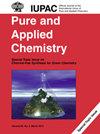Synthesis, characterization, and bioactivity test of dibutyltin(IV) dihydroxyibenzoate as disinfectant agent
IF 2
4区 化学
Q3 CHEMISTRY, MULTIDISCIPLINARY
引用次数: 0
Abstract
In this work, three organotin (IV) derivatives namely dibutyltin(IV) di-2-hydroxybenzoate (DBT2-HBz) (2), dibutyltin(IV) di-3-hydroxybenzoate (DBT3-HBz) (3) and dibutyltin(IV) di-4-hydroxybenzoate (DBT4-HBz)) (4) were synthesized and tested as disinfectant against pathogenic bacteria,作为消毒剂的二羟基苯甲酸二丁基锡(IV)的合成、表征和生物活性测试
在这项工作中,合成了三种有机锡 (IV) 衍生物,即二-2-羟基苯甲酸二丁基锡 (DBT2-HBz) (2)、二-3-羟基苯甲酸二丁基锡 (DBT3-HBz) (3) 和二-4-羟基苯甲酸二丁基锡 (DBT4-HBz) (4),并将其作为抗致病菌金黄色葡萄球菌的消毒剂进行了测试。化合物 2-4 是通过二丁基氧化锡(DBTO)(1)与 2-羟基苯甲酸(2-HBz)、3-羟基苯甲酸(3-HBz)和 4-羟基苯甲酸(4-HBz)反应制备的。合成的化合物通过紫外可见光、傅立叶变换红外光谱、1H NMR、13C NMR 和微量元素分析仪等光谱技术进行表征。化合物的光密度(OD)是在 600 纳米波长下用紫外可见光测量的,结果表明其对金黄色葡萄球菌具有良好的生物活性。所得数据表明,化合物 4 的生物活性高于化合物 2 和 3,以及使用含 5 % 苯扎氯铵的商用消毒剂进行的阳性对照。当化合物 4 的浓度为 5 × 10-4 M,接触时间为 10 分钟时,其生物活性最佳,吸光度从 0.6092 下降到 0.4005。化合物 2 的最佳浓度为 5 × 10-4 M,接触时间为 10 分钟,吸光度从 0.6092 降至 0.4416。与化合物 4 和 2 相比,化合物 3 和阳性对照的吸光度下降幅度较小。总之,研究结果表明,合成的化合物具有作为消毒剂对付病原菌的潜力。
本文章由计算机程序翻译,如有差异,请以英文原文为准。
求助全文
约1分钟内获得全文
求助全文
来源期刊

Pure and Applied Chemistry
化学-化学综合
CiteScore
4.00
自引率
0.00%
发文量
60
审稿时长
3-8 weeks
期刊介绍:
Pure and Applied Chemistry is the official monthly Journal of IUPAC, with responsibility for publishing works arising from those international scientific events and projects that are sponsored and undertaken by the Union. The policy is to publish highly topical and credible works at the forefront of all aspects of pure and applied chemistry, and the attendant goal is to promote widespread acceptance of the Journal as an authoritative and indispensable holding in academic and institutional libraries.
 求助内容:
求助内容: 应助结果提醒方式:
应助结果提醒方式:


